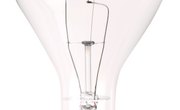
Technology for electricity has evolved over time, but the basic principles of positive and negative charges can be demonstrated by creating a simple battery with supplies around the house and from a small electronics or home improvement store. Also known as an air battery, a saltwater battery uses the positive and negative ions from salt in water to generate a small amount of energy, enough to power a small, low voltage light bulb. Metal electrodes can be fashioned from metal nails that are long enough to extend past the water line of the solution.
Prepare Base
Position your light bulb base at one end of the wooden board, leaving room on the other end for the ceramic cup.
Secure the light bulb base by attaching screws to the base and tightening with a screwdriver. Do not drive the screws flush into the base; instead, leave the top of the screws exposed so that you can attach alligator clips.
Insert the light bulb into the base and twist gently to tighten.
Saltwater Battery
- Small light bulb base
- Wooden board
- Two metal screws
- Screw driver
- Miniature light bulb and base
- Ceramic cup
- Salt
- Water
- Vinegar
- Bleach
- Stirrer
- Measuring cup and spoon
- Long iron nails
- Coated Copper wire
- Wire clippers and stripper
- Alligator clips (4)
- Voltmeter
Build a stronger battery by using a larger container (non-metal) and doubling the ingredients for the saltwater solution. Make sure the ends of your iron nails are above the water level (suspend with paper clip if needed). Consider connecting a small buzzer or clock, instead of the small light bulb.
Avoid spilling the saltwater solution near your components. It can create a short. Use containers made of materials that are poor conductors of electricity, such as ceramic or plastic. Do not use metal cups, bowls or containers.
Place one teaspoon of salt in the ceramic cup.
Dispense six ounces (3/4 cup) of water into the cup and stir to dissolve the salt.
Add one teaspoon of vinegar and 1/4 teaspoon of bleach into the solution; stir.
Cut two equal lengths of copper wire, so that each can extend from the light bulb base to the ceramic mug.
Strip the coating from each end of the wires and attach alligator clips to each. If desired, connect one color of alligator clips on each wire, so that one wire has two black ends and the other has two red ends.
Place the iron nails in the cup filled with saltwater solution, taking care that the nails do not touch each other and are not submerged.
Clip one end of one wire to the exposed top of one nail and clip the other end to one screw of the light bulb base.
Repeat step 7 for the other nail and the other screw on the light bulb base.
Observe the intensity of the lighted bulb.
Detach the alligator clips from the light bulb base and clip to the connectors on a voltmeter, if desired, to measure the voltage from your saltwater battery.
Things You'll Need
Tips
Warnings
References
Tips
- Build a stronger battery by using a larger container (non-metal) and doubling the ingredients for the saltwater solution. Make sure the ends of your iron nails are above the water level (suspend with paper clip if needed).
- Consider connecting a small buzzer or clock, instead of the small light bulb.
Warnings
- Avoid spilling the saltwater solution near your components. It can create a short.
- Use containers made of materials that are poor conductors of electricity, such as ceramic or plastic. Do not use metal cups, bowls or containers.
About the Author
Regina Edwards has been a freelance writer since 1990. She has penned video scripts, instructional manuals, white papers and abstracts. She has also ghostwritten diabetes journals. Edwards is a scuba instructor and Usui and Karuna Reiki teacher. She holds a Bachelor of Science from Saint Joseph's University.
Photo Credits
Photos.com/AbleStock.com/Getty Images
